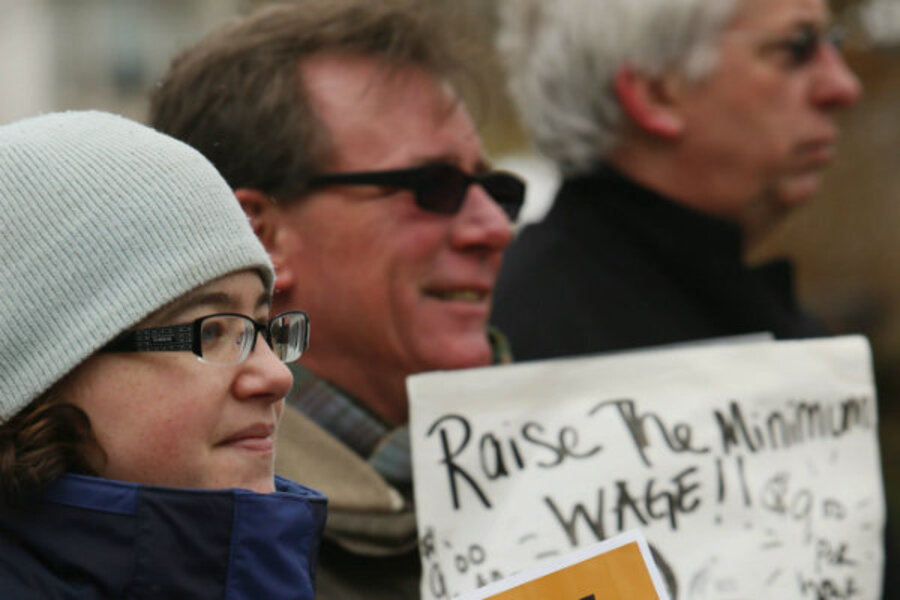Equal Pay Day: Raising minimum wage will help women – and the economy
| Washington
For more than three decades, Amie Crawford was a successful interior designer, transforming residential and commercial spaces in Washington, D.C. and North Carolina. Her team was even shortlisted to renovate the Pentagon.
In 2011, she moved to Chicago to be close to her family. For months, she scoured job postings, attended job fairs, and sent out dozens of resumes. The recession, however, proved insurmountable. The 56-year-old had to settle for a restaurant job at $8.25 an hour, the minimum wage in Illinois. Fourteen months later, Ms. Crawford is barely getting by. She draws on her retirement savings daily and receives $150 in food stamps monthly.
Crawford isn’t alone. Millions of Americans make the federal minimum wage of $7.25 an hour, don't have any savings, and have to support a family, to boot. They toil tirelessly for a wage entirely divorced from living costs in today's economy.
America's workers are shouldering more but receiving less. A full-time minimum wage employee earns $14,500 a year, roughly $4,000 below the poverty line for a single mother with two children. If the minimum wage had kept pace with inflation since 1968, it would now be almost $10.60 an hour. If it had kept pace with increases in employee productivity, it would now be $22.00 an hour.
Countless workers are harmed by these low wages, women especially. Today, Equal Pay Day, serves as a stark reminder of that reality. April 9, 2013 marks how far into 2013 a woman must work to match what a man earned in 2012. Women represent nearly two-thirds of all minimum wage workers and are a large majority of workers in the 10 largest occupations typically paying less than $10 an hour: They constitute 88 percent of home health-care professionals, 88 percent of maids and housekeepers, and 94 percent of childcare workers. They also represent about two-thirds of tipped workers – and the tipped minimum cash wage of $2.13 per hour hasn’t been raised for more than 20 years.
Raising the minimum wage wouldn’t just help these women make ends meet; it would also help close the gender wage gap. In 2011, women working full time, year round were paid only 77 cents for every dollar paid to men. The wage gap was even larger for women of color: Black women working full time, year round made only 64 cents, and Hispanic women only 55 cents, for every dollar paid to white, non-Hispanic men.
Of course, multiple factors contribute to the wage gap, including pay discrimination, family caregiving obligations that constrain women’s employment opportunities, and the undervaluing of work traditionally performed by women. But the bottom line is that women – and their families – are disproportionately affected by the low minimum wage.
New legislation introduced last month in Congress – the Fair Minimum Wage Act of 2013 – would over the course of three years, gradually increase the minimum wage to $10.10 and increase the minimum cash wage for tipped workers to 70 percent of the regular minimum wage, indexing both to inflation. The bill would increase the gross earnings of a full-time minimum wage employee by $5,700 a year, lifting a family of three above the poverty line.
Critics argue that a wage increase would hurt employment and increase poverty. And a few studies have shown small negative effects on employment. But the bulk of the evidence suggests otherwise. In a study published in November 2010, for example, three economists studied 16 years of data, and compared counties where the minimum wage increased to neighboring counties where it didn’t. They found no detrimental impact on employment.
Other economists have gone further, concluding that a wage increase would stimulate the economy. The thinking is that low-income employees tend to immediately spend the additional money they earn on groceries, housing, transportation, and other expenses. Corporate profits would increase, and businesses would expand.
Take San Jose,Calif. In the spring of 2011, a group of college students and their professor at San Jose State organized a grass-roots campaign to raise the city's minimum wage from $8 to $10. Critics echoed the familiar chorus that the measure would kill jobs and force residents to relocate. The students persisted, and with the support of labor, nonprofit, and community groups, the measure passed.
The wage increase took effect earlier this month, and while still early, initial feedback has been encouraging. Though Scott Knies, executive director of San Jose’s Downtown Association, has said that some businesses have raised prices or cut employee hours, others expect much of the extra $70 million now in workers’ pockets to be spent locally, boosting business.
One business owner is even considering raising wages in other cities because he believes fair compensation improves his bottom line. He’s in good company. Researchers have found that higher wages increase worker productivity and reduce employee turnover.
Congress has raised the minimum wage only three times in the past 30 years. For millions of women, especially, time is running out. In a country that prides itself on social mobility and equal opportunity for all, isn’t it time to give all workers a livable wage?
Emily Martin is vice president and general counsel at the National Women’s Law Center.
Arjun Sethi is a lawyer in Washington, D.C., whose writing on civil rights and social justice issues can be found at www.arjunssethi.wordpress.com. Follow him on Twitter at @arjunsethi81.





